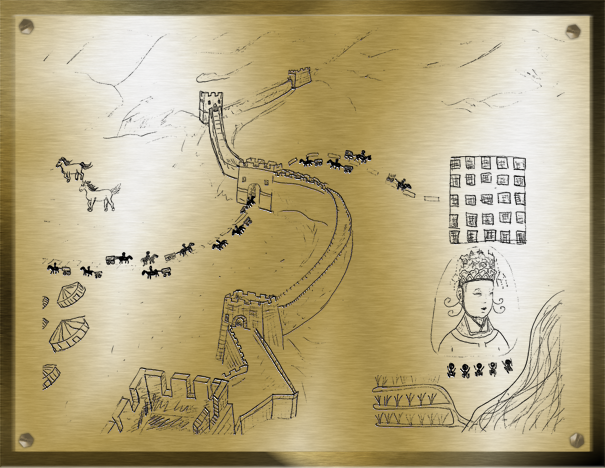| Time Period | 600 – 700 CE |
| Geographical Region | Chang’an, Great Wall, and Mongol territory |
| List of Symbols |
|
The meaning that these symbols display collectively is a time of great prosperity in China during the Tang Dynasty in about 600 CE, particularly under the rule of Empress Wu. During the Tang, Nomads, Middle Easterners, and other peoples were allowed into China through the Great Wall via the Silk Road. The entire upper region of the plaque is covered in mountains. The Great Wall rests on mountain ridges, and is displayed cutting through the center of the plaque. On the left, a dashed line runs off the page, this line is the Silk Road. Next to the Silk Road lie yurts, wild horses, and vast expanses of land without cities, signifying that is where nomadic people live. The Silk Road continues through an open gate in the Great Wall. The dashed lines, Silk Road, end at a series of squares in rows; this symbolizes the Tang capital city of Chang’an. These symbols are included in the plaque to show where Tang China, specifically Chang’an was located.
The Great Wall is displayed in the plaque to inform viewers of where Tang China is located. The Great Wall was originally built to keep barbarians out and Chinese civilization in. However, under the Tang Dynasty, the Great Wall was open to those who traveled along the Silk Road. People had already been trading along the Silk Road for hundreds of years. During the Tang, it fostered trade for everyone from Chang’an, China to modern day Europe. The Silk Road was crucial to every country along it. If one gained control of the Silk Road, they could make a lot of money by taxing goods traded in the Silk Road and by making other countries pay tribute. Overtime several peoples had taken control of the Silk Road, but because the Silk Road ended in Chang’an, those who ruled Chang’an typically had much control over it. As the end of the Silk Road, Chang’an was a very important city. The city is signified in the plaque by several rectangles in rows, this is because Chang’an was structured in a grid system, where every block had various buildings, such as houses, temples, parks, etc. There were large roads and narrow alleys. Chang’an was not like other cities of this time. In fact, it was the largest city in the world at that time, holding a population of about 1 million people. People moved to Chang’an from all over the world in search of wealth and success. Living in Chang’an gave one access to goods from other countries, and enabled one to sell goods to people from other countries. As shown in the plaque, people are depicted riding horseback along the dashed lines both towards Chang’an and away from Chang’an. Signifying that under the Tang there was a particularly large involvement in trade.
Empress Wu is depicted below Chang’an, as the bust of a woman in an elaborate headdress. The only female Emperor in China’s history was Empress Wu, and she ruled during the Tang Dynasty. She technically made her own dynasty, called the Zhou Dynasty, but this dynasty was just her and interrupted the Tang dynasty. Below her are men bowing, symbolizing that she was the ruler. Chang’an was the capital city of Tang China, and where Empress Wu lived in her palace. Chang’an was particularly prosperous under Empress Wu. She made education and entertainment available to anyone. In the bottom right corner of the plaque, below Empress Wu, lies a body of water which feeds an irrigation system used to cultivate crops. Empress Wu had irrigation systems created to further develop agriculture of Chang’an. She also had textbooks created for farming to allow accessible knowledge of farming to others. Due to Empress Wu, food was not scarce. People had time and energy to spend on leisure and creativity because they were not worrying about their next meal. During the Tang there was not as large of a divide between the Upper class and the Lower class. For example, entertainment was not only for the rich to enjoy, in fact anyone could attend concerts and performances, they were free. Some concerts had over 700 performers. Empress Wu also refined the civil service exam by personally interviewing and choosing candidates. Therefore making it possible for men of ability but not of high birth to enter the civil service, and preventing appointments from being achieved by bribery and corruption. Having the only female emperor, and giving the people access to opportunities is something that the Tang Dynasty is known for.
Not only Chang’an, but all of Asia benefited during the Tang Dynasty, particularly under Empress Wu. The opening of the Great Wall allowed people to travel across Asia and trade goods along the silk road. The sharing of cultures throughout Asia fueled Chang’an as a center for creativity and prosperity. This is depicted by the multitudes of people traveling along the dashed lines, Silk Road, across the plaque from Chang’an to countries beyond.
 SOFIA SALEN is a Mathematics Major and Chinese Minor at the University of Rochester. She holds two positions in SA Government: Associate Director of Public Relations and The Mural Project Coordinator. In her spare time she enjoys painting. More by Sofia
SOFIA SALEN is a Mathematics Major and Chinese Minor at the University of Rochester. She holds two positions in SA Government: Associate Director of Public Relations and The Mural Project Coordinator. In her spare time she enjoys painting. More by Sofia
